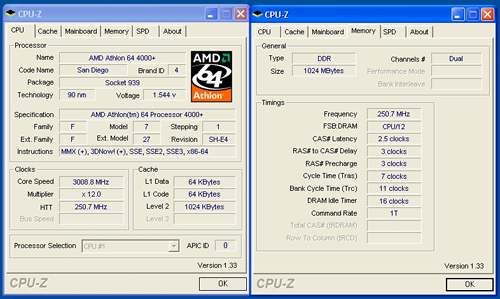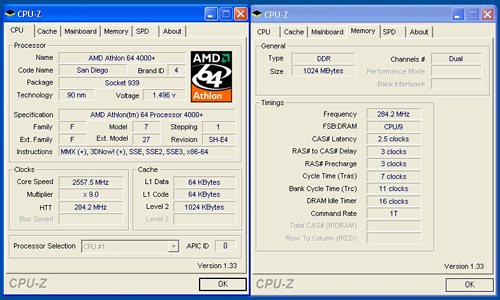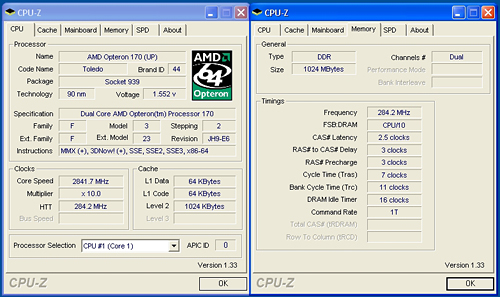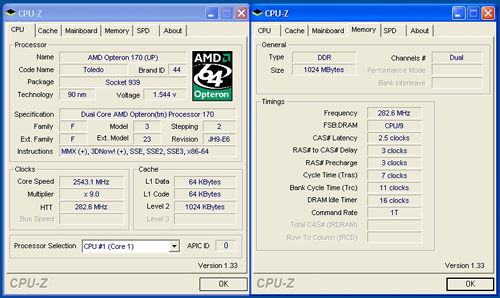FSB Overclocking Results


Our 4000+ CPU posted very good results in the stock multiplier overclocking test. We were able to reach a very stable overclock of 251HTT x12. We were also able to boot Windows with a 256HTT x12 setting but could not complete our entire test suite.
Unfortunately, our maximum HTT speed attained was 284HTT x9. The board could POST at 292HTT x9 but was not stable. We were unable to POST at 300HTT or higher, though this processor has completed testing at a 330HTT x9 setting in the past.
We have contacted MSI engineering at this time and hopefully our results are due to a below average board as end users and other websites have exceeded the 300HTT level with the 3.0a BIOS. 284HTT isn't terrible, particularly when using higher CPU multipliers, but neither is it exceptional. Also, voltage levels remained consistent throughout testing. We did not notice any abnormal or out of range voltage fluctuations with this board.


Our Opteron 170 posted excellent results at the stock CPU multiplier settings but was hampered once again at the lower multiplier setting. At these overclocked settings the system was able to complete all of our benchmark test suites three consecutive times and run Prime95 for a minimum of four hours without issue. Overall the board would make an excellent platform for overclocking if the maximum HTT settings are improved.
Memory Stress Testing
Memory stress tests look at the ability of the MSI K8N Diamond Plus to operate at the officially supported memory frequencies of DDR-400 at the best performing memory timings the OCZ PC4800 Platinum Edition will support.
The MSI K8N Diamond Plus was superbly stable with 2 DDR modules in Dual-Channel mode at the settings of 2-2-2-5 at 2.7v. We were able to operate the memory at this configuration up to a 227HTT x12 setting. We will now install all four available memory slots that results in more strenuous requirement on the memory subsystem than testing 2 DDR modules on a motherboard.
The MSI K8N Diamond Plus was extremely stable with 4 DDR modules in Dual-Channel operation at the settings of 2-2-2-8 but required the command rate be increased to 2T along with a voltage increase to 2.75. We tested memory modules from several different suppliers with the same results.
| Front Side Bus Overclocking Testbed | |
| Processor | AMD Athlon 64 4000+ (San Diego) AMD Opteron 170 (Denmark) |
| CPU Voltage AMD Athlon 64 4000+ AMD Opteron 170 |
1.550V (1.400V default) 1.550V (1.350V default) |
| Memory Settings | 2.5-3-3-7 1T - (12x) 2.5-3-3-7 1T - (10x) 2.5-3-3-7 1T - (9x) |
| Memory Voltage | 2.8V |
| HT Multiplier | 4x - 250HTT ~ 285HTT |
| Memory | OCZ PC4800 Platinum Edition |
| Cooling | Tuniq Tower 120 |
| Power Supply | PC Power and Cooling 850 SSI |
| Maximum CPU Overclock AMD Athlon 64 4000+ |
251HTT x 12 (3008MHz) +25% |
| Maximum HTT Overclock AMD Athlon 64 4000+ |
284HTT x 9 (2557MHz) +42% |
| Maximum CPU Overclock AMD Opteron 170 |
284HTT x 10 (2841MHz) +42% |
| Maximum HTT Overclock AMD Opteron 170 |
282HTT x 9 (2543MHz) +41% |


Our 4000+ CPU posted very good results in the stock multiplier overclocking test. We were able to reach a very stable overclock of 251HTT x12. We were also able to boot Windows with a 256HTT x12 setting but could not complete our entire test suite.
Unfortunately, our maximum HTT speed attained was 284HTT x9. The board could POST at 292HTT x9 but was not stable. We were unable to POST at 300HTT or higher, though this processor has completed testing at a 330HTT x9 setting in the past.
We have contacted MSI engineering at this time and hopefully our results are due to a below average board as end users and other websites have exceeded the 300HTT level with the 3.0a BIOS. 284HTT isn't terrible, particularly when using higher CPU multipliers, but neither is it exceptional. Also, voltage levels remained consistent throughout testing. We did not notice any abnormal or out of range voltage fluctuations with this board.


Our Opteron 170 posted excellent results at the stock CPU multiplier settings but was hampered once again at the lower multiplier setting. At these overclocked settings the system was able to complete all of our benchmark test suites three consecutive times and run Prime95 for a minimum of four hours without issue. Overall the board would make an excellent platform for overclocking if the maximum HTT settings are improved.
Memory Stress Testing
Memory stress tests look at the ability of the MSI K8N Diamond Plus to operate at the officially supported memory frequencies of DDR-400 at the best performing memory timings the OCZ PC4800 Platinum Edition will support.
| MSI K8N Diamond Plus Stable DDR-400 Timings - 2 DIMMs (2/4 slots populated - 1 Dual-Channel Bank) |
|
| Clock Speed | 200MHz |
| CAS Latency | 2 |
| RAS to CAS Delay | 2 |
| RAS Precharge | 2 |
| RAS Cycle Time | 5 |
| Command Rate | 1T |
| Voltage | 2.7V |
The MSI K8N Diamond Plus was superbly stable with 2 DDR modules in Dual-Channel mode at the settings of 2-2-2-5 at 2.7v. We were able to operate the memory at this configuration up to a 227HTT x12 setting. We will now install all four available memory slots that results in more strenuous requirement on the memory subsystem than testing 2 DDR modules on a motherboard.
| K8N Diamond Plus Stable DDR-400 Timings - 4 DIMMs (4/4 slots populated - 2 Dual-Channel Banks) |
|
| Clock Speed | 200MHz |
| CAS Latency | 2 |
| RAS to CAS Delay | 2 |
| RAS Precharge | 2 |
| RAS Cycle Time | 8 |
| Command Rate | 2T |
| Voltage | 2.75V |
The MSI K8N Diamond Plus was extremely stable with 4 DDR modules in Dual-Channel operation at the settings of 2-2-2-8 but required the command rate be increased to 2T along with a voltage increase to 2.75. We tested memory modules from several different suppliers with the same results.










42 Comments
View All Comments
Odeen - Wednesday, April 12, 2006 - link
Hi,I wish you guys would post the EXACT BIOS (and, as necessary, jumper) settings you used to achieve your best overclocks, plus any issues you had with certain settings, etc. I'd love to see the actual notes from the lab, i.e. "Tried this clock skew value, crashed after X minutes."
While this wouldn't solve every overclocker's question, it would at least set us on the right path in optimizing our own systems, in terms of how certain values affect things.
I imagine you guys have a better understanding on what the BIOS settings do, as opposed to us everyday enthusiasts, who operate primarily on coincidences and conjectures. Especially in this age of hyper-tweakable motherboards with more and more components, it'd be really nice to know, for example, whether the hypertransport multiplier between the "NB" and the "SB" should match the chip-NB hypertransport multiplier, or whether that hypertransport bus speed is independent of HTT, and can be kept at 200/5X regardless of HTT value.
Lastly, have you tried the firewall drivers on this board, and does the firewall STILL cause bluescreens and corrupt downloads?
Gary Key - Wednesday, April 12, 2006 - link
We will need a new server to handle the notes sections for some of these boards. ;-)
We are probably heading in this direction shortly, especially for the enthusiast level boards. I will see what we can do on the next enthusiast level board with a table chart and short descriptions on how we arrived at the settings. I will say this, sometimes leaving most of the settings on Auto works best, the board/bios engineers are usually very smart about the default settings and then when you think all is okay, they hit you with a setting that should never be a default item.
We found on the MSI board, the NB-SB, SB-NB, and CPU-NB HT settings had to be synchronized or the board had stability issues. In fact, the CPU-NB default setting was at 800MHz, we had to change the option to manual, and then bump it up to 1000MHz to match the NB-SB and SB-NB HT settings at stock speeds. It does appear we had an average or below average board for the review, the latest retail sample that MSI pulled from their warehouse was able to post at 318HTT x9 with our test components.
If they are more details you would like to know, please comment or email me.
We tried the firewall with the 6.85 drivers. We could only recreate one particular situation that resulted in a corrupt download. It required the use of BitComet, downloading seven plus files (each over 200MB) concurrently, transferring the files to a media folder, and then unzipping a file while three others were still downloading. It only did it once but it did do it, is it NVIDIA or something else? I personally have not experienced any BSODs or corrupt downloads with the latest drivers, a clean load of XP, and staying away from the P2P software.
We have a new NVIDIA Business Platform system on its way so it should be interesting to see the tweaked ActiveArmor suite and driver updates that NVIDIA has been working on extensively over the last ninety days.
Gary Key - Wednesday, April 12, 2006 - link
Just not my week....Should read - If there are more details you would like to know, please comment or email me.
slashbinslashbash - Tuesday, April 11, 2006 - link
PLEASE learn the difference between "discreet" and "discrete".JarredWalton - Tuesday, April 11, 2006 - link
I don't know about you, but I like my audio solutions to be unobtrusive. Nothing worse than audio that gets in your face with static and stuff.... ;)mbhame - Tuesday, April 11, 2006 - link
"Our initial impression of the MSI K8N Diamond Plus upon opening the box is that it has an extensive feature list, cluttered yet clean layout, heat-pipe cooling system, and that the overall quality of components utilized by MSI is very good."...how can a layout be 'cluttered yet clean'?
JarredWalton - Tuesday, April 11, 2006 - link
Cluttered in that there is a LOT of stuff; clean in that it still works and there aren't any issues with connecting everything. It's an oxymoron, like "little giant". :)nullpointerus - Tuesday, April 11, 2006 - link
Now I know how to describe my room.nullpointerus - Tuesday, April 11, 2006 - link
Where are these PCIe 1x cards I've been hearing about? What exactly is available on PCIe besides video/network cards? I've heard that it's going to be a very long, slow transition to PCIe for sound cards due to noise/power issues with the spec.DigitalFreak - Tuesday, April 11, 2006 - link
See http://www.siig.com/productList.asp?pid=1013&c...">this page for examples. I do wish they made PCI-E sound cards though.